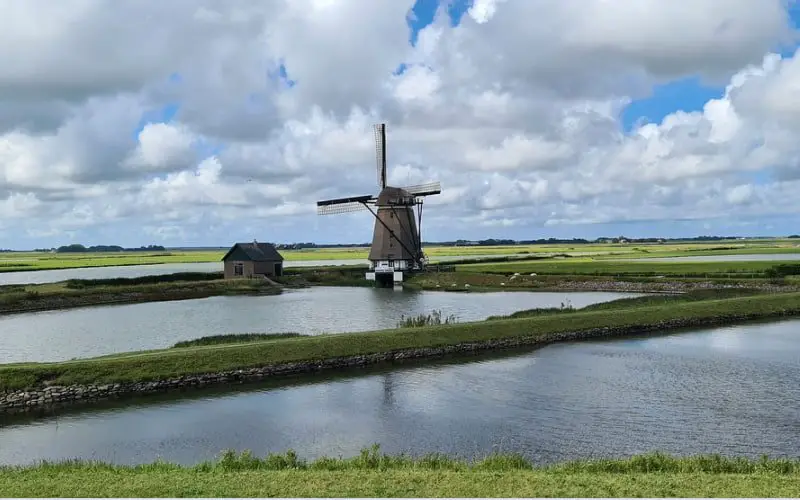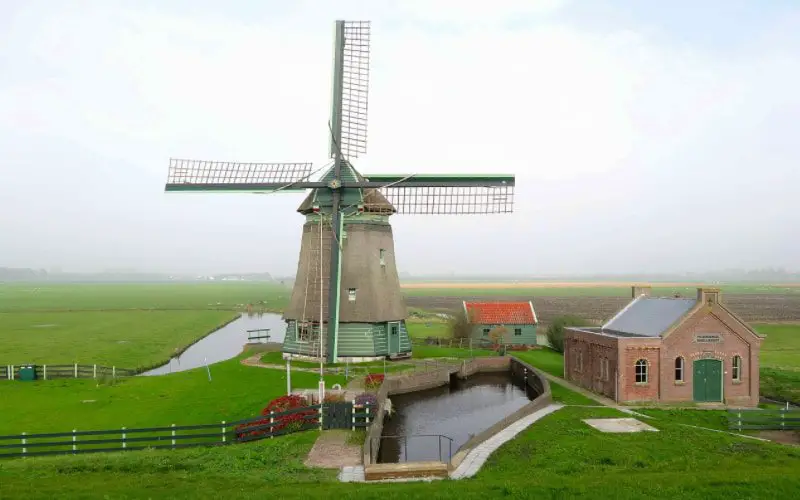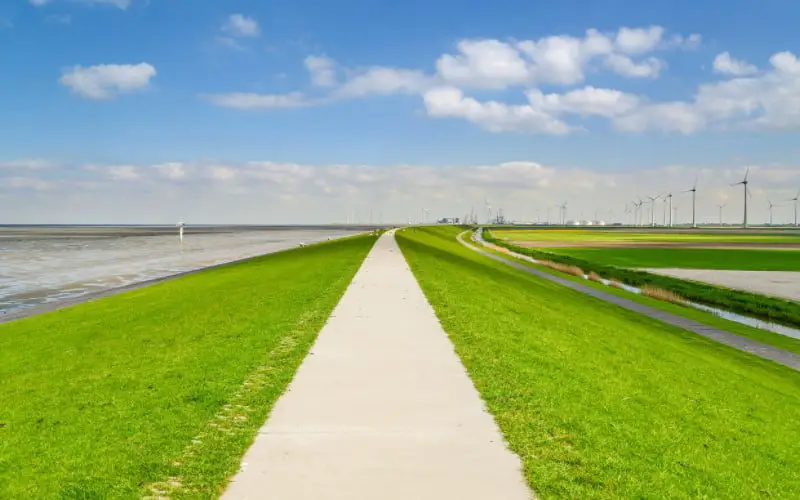

The Netherlands is full of towering people but devoid of mountains. The scarcity of highlands and mountains in the Netherlands might make you wonder, “Is the Netherlands the Flattest Country in the World?”
The Netherlands is not the flattest country in the world. The Maldives is the flattest country in the world. However, the Netherlands is the flattest country in Europe.
If you want to learn more about what makes the Netherlands so flat, then please read till the end. We’ve also discussed how this flatness has made the country vulnerable to the effects of climate change and how its government is fighting to literally keep the country afloat.
The Netherlands is so flat that it is named after its naturally flat topography and low elevation. The word “Nether” means in Dutch, downwards, and hence the Netherlands literally stands for “lower lands.” It is so flat the French call the Netherlands, Pays-Bas, which means the lowlands.
The tallest hill in the Netherlands is as high as the Eiffel Tower. The Vaalserberg, which is located in the southeastern part of the Netherlands, is approximately 322.7 meters (1056 feet) high.
Along with Belgium and Luxembourg, the Netherlands is known as the Low Countries of Europe. The highest points of Belgium and Luxembourg are around 700 meters (2296 feet) and 600 meters (1968 feet), respectively. For this reason, the Netherlands beats its neighbors and becomes the country with the lowest height in Europe.
Besides the southern part of the Netherlands, most of it is just a meter above sea level. The lowest point of the Netherlands, Zuidplaspolder, is literally 6,76 meters (22 feet) below sea level.
Other than a few hills like Cauberg and Keutenberg, most of the Netherlands consists of low-lying lands. You could say the Netherlands is as flat as a pancake with little blips here and there.
The mean average elevation of the Netherlands is approximately 30 meters above sea level. The mean elevation of Denmark is 34 meters, making the Netherlands the flattest country in Europe.
If you take a train from Germany to the Netherlands, you will know you have crossed the border when the horizon becomes clear. When you look out the window, you will see only a straight line dividing the sky from the land. Just by looking at the Dutch horizon, you can understand how flat the Netherlands truly is.
There are two main reasons why the Netherlands is so flat. One reason is completely natural, and the other is man-made.
The topography of the Netherlands is naturally flat because it is the drainage basin of Western Europe. The Rhine, the Eems, the Scheldt, and the Meuse are four major European rivers. Three of these rivers flow through the Netherlands and fall into the North Sea from the Dutch coastline.
If you look at the Dutch countryside, you will only find flat plain land. All this is because 1/5 of the land is taken from the sea, marshes, and lakes.
There is a famous proverb in the Netherlands, “God created the Earth, but the Dutch created Holland”. This proverb reflects the sheer skill of the Dutch engineers who reclaimed land from underwater. But this engineering skill is much of the reason why the Netherlands is so flat.
The reclaimed lands make up about 1/5 of the Netherlands. These lands are also the ones that are a meter above sea level and thus devoid of highlands.
Moreover, much of these lands were made by filling up water bodies with sand. Hence, this man-made land built by men is one of the reasons why the Netherlands is so flat.
A Dutch windmill that's being used to pump water out of the countryside:

The Dutch have been keeping water out from their lowlands since the primitive ages using dikes. The man-made embankments kept water out of their farmlands and protected them from the North Sea.
Today, they don’t use dikes alone. The Dutch anti-flooding and water management system is much more sophisticated. From the 14th century, they even started reclaiming land from the sea and turning it into agricultural land.
The Dutch built dikes, canals, dams, and windmills to keep water out of their land. They not only built dikes near the sea, but they also built them near wetlands, fenlands, marshlands, and lakes. These low-lying areas surrounded by dikes were called polders.
The Dutch started using windmills in the 15th century. Using windmills, the Dutch drained out water from the polders and reclaimed land. They planted trees to make these lands firm. The lands were fertile and very flat.
There are around 4000 polders in the Netherlands today. There are around 17.691 kilometers (11.000 miles) of dikes around these polders and all over the nation, keeping them protected from floods.
In the Netherlands today, polders are densely populated. Most of the infrastructure of the Netherlands is built on it. Buildings in these areas are built on wooden poles and concrete piles. These polders also need to be drained regularly, or else water will flood the cities.
The government created waterschap or water boards to combat floods. They also took on construction projects such as the Delta Works to protect Dutch lands from the sea. Delta Works is a large system of dikes, storm barriers, and locks that helps to keep out water from the Southwestern region of the Netherlands.
Dikes protecting the Netherlands from the sea:

The answer to this question is both yes and no. The Netherlands is slowly sinking, but not only because of global warming.
The windmills and pumping stations that drained the Netherlands and kept it from flooding are also the reason why it is sinking. Every year the country is sinking by 4 to 8 millimeters (0.15 to 0.31 inch). The condition is made worse by global warming.
Around 55% of the Netherlands is below sea level, and the rising sea level fuelled by global warming is not making things better.
The warmer summers caused by global warming dry out the land faster. This causes the peat soil to oxidize, causing it to sink to the groundwater level. This creates a huge problem for the infrastructure and urban population of the Netherlands.
The sinking land increases the risk of floods, destabilizes the roads, and creates cracks in foundations. What is worse is that not only is the sinking accelerated by global warming, it is also accelerating global warming. Meaning the sinking of one centimeter of Dutch peat soil releases 9 tons of carbon dioxide into the environment.
So, the sinking of the Netherlands is a huge climate issue for both the country and the world. But unlike a certain superpower country, the Dutch Government does not deny the existence of climate change.
The Dutch government realizes that they cannot keep on building higher levees. The Netherlands is sinking due to these levees and continuous water draining of the windmills. That is why the government took on a project called “Room for the Water.”
The Dutch plan to build inland water reservoirs that will “catch” flood water. Their plan is to live with water instead of fighting against it. Instead of blocking water, they plan on letting water flow. Hence they are developing flood catchment zones under projects like “Room for the Water.”
Moreover, the Dutch government is leaning toward using renewable energy. They are creating “Solar Islands” to combat rising sea levels. They are developing 15 islands consisting of 73,500 solar panels in North Holland. The solar islands will be put on water after they are completely made and tested.
The Dutch survived by building the Netherlands from under the sea level; today, they plan to adapt again and live with the water. They plan to deploy their energy source on the water from land. Besides the solar panels, the Netherlands also has a lot of wind turbines placed in the sea. If you would like to know more about how the Netherlands makes use of the wind, please check out this article.
Despite being one of the flattest countries in the world, they survived in the Netherlands because of their adaptability and resilience. Unlike countries that ignore climate change, the Dutch are trying to find new ways to adapt to the new world.
I hope this article not only answered your question, “Is the Netherlands the flattest country in the world?” but also gave you an idea of the resilience and brilliance of the Dutch nation.